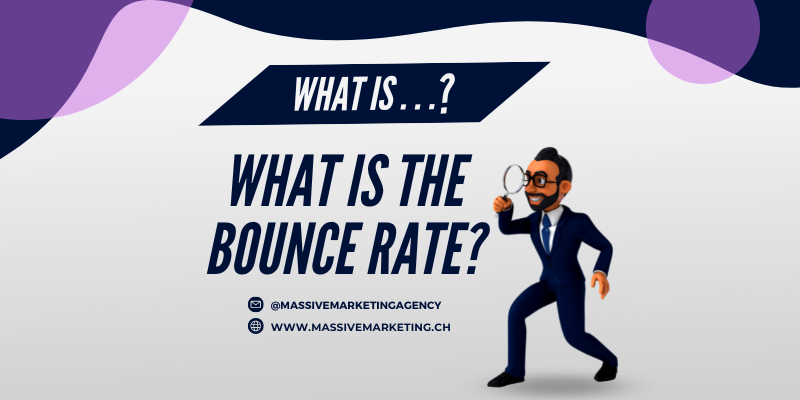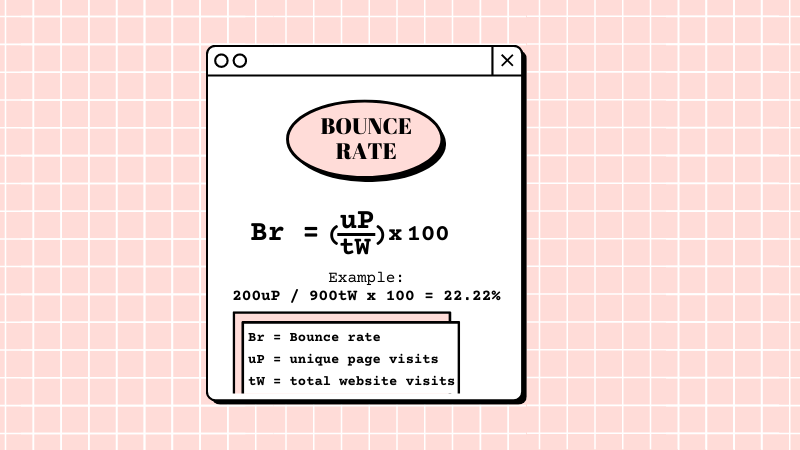
What is Bounce Rate?
The bounce rate of a website is of crucial importance as it provides information on how well or poorly visitors engage with the content of a website.
The bounce rate is calculated when someone visits a single page on your website or online shop and actually does nothing on the page before leaving. So a website’s bounce rate simply measures how many visitors leave a page without making a specific action, such as clicking on a link or button, filling out a form or buying a product.

Now that you know what the bounce rate of a website is, let’s look at how you can calculate the bounce rate using the visual formula above.
It’s simple – you just need to find the number of unique page visits (the sessions that ended after visiting a single page) and divide it by the number of all visits within a certain period of time (e.g. a month) on your website.
Let’s take a look at our beloved bounce rate in conjunction with Google Analytics.
What is Bounce Rate in Google Analytics?
It is quite easy to define the bounce rate in Google Analytics, as it has the same meaning as the bounce rate we explained above, only with a more complex procedure.
What does it mean? Google Analytics defines a bounce as a single request to the Google Analytics server, for example a visit to a single page on your website, which is then left without further action.
This means that Google Analytics does not count this as a bounce even if the user, for example, presses “Play” to watch a video on that page, shares a post with someone, logs in or clicks “Read more” to access a larger piece of content.
To be counted as a bounce in Google Analytics, a session must consist of a user accessing a page and then leaving without interacting with any elements of the site. Not at all.
Exit Rate vs Bounce Rate
Now that we have found out what bounce rate is in Google Analytics, let’s talk about exit rate – what is the difference between exit rate and bounce rate?
Well, first of all, they sound quite similar and are easy to confuse at first glance. And they often are.
As you already know, bounce rate is the visit to a single page where the user leaves a website immediately after visiting that one page without interacting in any way with the elements of the website. The visitor comes and goes – that’s a bounce.
Exit rate is the percentage of users who leave a page after visiting several other pages on the same website. Once users find your website in search results, they land on it. After reading the content, they may have difficulty with the terms or want more information about your company and product, so they follow other links. If they leave your website after visiting several pages, the exit rate will increase and have a negative impact on your business. To prevent this, take note of your underperforming pages and do everything you can to optimize them.
So, in that sense, every single page on a website is an exit page, so why even count them?
Well, here’s the thing. Exit rates are counted for a specific page, not for an entire website. They are used to determine how visitors leave a particular page. This means that some pages, such as homepages, are less likely to increase your exit rates, while blog pages are more likely to do so.
The more visitors leave a particular page, the higher its exit rate.
What is a good Bounce Rate?
So the common view about bounce rates is that they are bad. Just like drinking Jack Daniels & Coca-Cola at 9:45 in the morning is bad (as some say).
But it turns out that even the bad guys have a soft side and a stack of music CDs hiding in the back drawer, along with bounce rates that aren’t as bad as they seem. To be honest, it all depends on your website. Here’s an explanation of bounce rate.
The average bounce rate for all websites is around 40 per cent. If you have a blog that mainly provides news and articles for your readers, the average bounce rate for your website is around 70-90%.
In this case, users have searched for a specific topic, found what they were looking for and left the site after reading the information they wanted. The main purpose of the blog is done with this. The more readers you have, the more successful your blog is and the more you earn through placed ads and other forms of monetization.
The average bounce rate for e-commerce websites, on the other hand, is quite different. E-commerce is all about sales. Whether you offer blog articles, free content or subscriptions, you need to sell your product and that’s all that really matters. A good bounce rate in e-commerce is around 10-30%, that’s a very different number to blogging, isn’t it?
The real answer to the question “What is a good bounce rate?” depends on the nature of your website, your goals and your sales method. But regardless of what you offer, it is always a good idea to find out how to improve your bounce rate, which we will talk about in the next section.
How to improve the Bounce Rate?
Do you have a higher bounce rate than expected? Do you feel you can do better? You probably can, and that’s why we’ve put together this list of how to improve a website’s bounce rate. Consider the following proven strategies to lower your bounce rate, improve user experience and drive more sales.
1. Enhance the User Experience
Taking an objective look at how you can improve user interaction with your website, pages, brand and services is a good starting point to combat a high bounce rate.
Tips:
- Use screen recording software to track how users explore your website and identify any potential bottlenecks.
- Check the simplicity and intuitiveness of your website navigation.
- Consider an independent website survey to get valuable feedback.
2. Optimize your “Call to Action” and On-Page CRO
Make sure your call to action is clear, concise and meaningful. You probably only have a few seconds to engage with your visitor. And most importantly, make sure the content matches that call to action. If the content doesn’t match what users are expecting or looking for, you should hit the “Back” button.
Tips:
Make sure your key messages and ‘hook’ are in the foreground without the user having to scroll.
- Don’t give them too many options
- Focus on the desired topic on the page
- Focus on solutions and benefit statements early on and save the “features” for further down the page.
3. Audit Page Load Speeds
Use tools like Pingdom, GTmetrics or Google PageSpeed Insights to find out which pages on your website take too long to load. Research has shown that websites that take up to 3 seconds to load can cause up to 40% of visitors to ‘bounce’, with every 1 second of loading time reducing sales by up to 7%.
Tip:
- Remember that many of your visitors may have slower mobile connections. For example, while the loading time for desktop computers is 2 seconds, it can be 6 or more seconds for a 3G connection.
4. don’t be afraid to A/B test the content of your page.
Although the main content of the page should be adjusted with care, it is a good idea to test headings, calls to action, buttons, colours and layouts, especially at the top if SEO is a concern. Make sure you have some data to compare the changes with.
Tips:
- Only test one variable at a time
- Make sure you have enough data/visitors to make your decisions statistically reliable.
- You may find that simple changes have a big impact.
5. Incorporate Multi-Media
In today’s digital era, visitors are hungry for high-quality multimedia content. Some studies have shown that including media such as high-quality images and videos can increase conversion rates by up to 34% (Aberdeen Group). A website with videos and pictures is simply beautiful to look at.
Tips:
- Hire a graphic designer to create powerful, unique images
- Consider adding an introduction, explainer video or video testimonial.
- Make sure all video content is related to the topic you are covering.
6. Take Customer and Visitor Feedback to Heart
Sometimes the customer is ALWAYS right. Don’t let your ego or lack of follow up stop you from giving your audience what they need, demand and deserve.
Tips:
- Feedback from visitors and customers should be shared across all departments to create a synergistic approach to better serving your audience.
- Collect feedback from emails, chats, social media, review platforms and other channels.
- Read and respond to comments
7. Mobile-Friendly Design
With more than 50% of all internet traffic coming from mobile devices, it is essential that your website is optimised for mobile devices and responsive. If this is not the case, mobile users will leave the site immediately if they see that images are not loading.
Tips:
- Test responsiveness on multiple devices
- Make sure CTAs are easy to read and convert on mobile devices.
- Test and optimise the loading speed of the page for mobile devices
8. Improve the Readability of your Content
Did you know that the average US citizen only reaches 8th grade reading level? Smart content writers therefore target this reading level not only with their vocabulary but also with their sentence structure and length. If you confuse the reader, they will go elsewhere.
Tips:
- Divide long paragraphs into smaller and easier-to-digest paragraphs.
- Separate your content with subheadings
- Use simple examples to illustrate complicated concepts or topics.
9. Take Advantage of Exit Popups
Exit pop-ups are triggered when it is detected that the user is about to leave your site. When a popup is triggered, it usually displays a message asking them to wait or a link to their email subscription. These popups can make some visitors think twice, but they can also be a bit annoying.
Tips:
- Make sure the popup closes easily, otherwise users will push back to escape.
- Make sure the pop-up contains useful information.
- Do not take up the whole screen
10. Make External Links Open in a New Tab
External links are important for any website because they usually show visitors where a particular piece of information came from or lead them to an interesting page or useful tool. Regardless of why you have them, if they replace your own page, your bounce rate will suffer.
Tips:
- Test all links on each page to ensure that all outbound links open in a new tab.
- Check for broken links
- Make sure the links you add are safe for visitors.
That’s it!
We hope this article helps you improve your bounce rate so you can grow your business.
Don’t forget to follow us on Instagram, Facebook and Twitter for more helpful marketing tips.
Further blog posts can be found here: Marketing Blog

